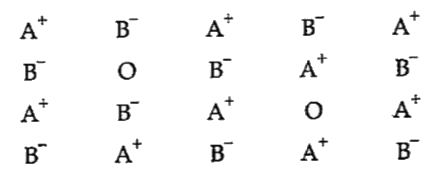The statements which are the about stoichiometric defects
the density may be less than pure crystal
the density must be less than pure crystal
the electrical and thermal conductivity may be more than pure crystal
the electrical and thermal conductivity must be more than pure crystal
The correct Answer is:A, D
To solve the question regarding the statements about stoichiometric defects, we will analyze the properties of two types of stoichiometric defects: Schottky defects and Frankel defects.
1. Understanding Stoichiometric Defects:
- Stoichiometric defects are imperfections in a crystal lattice that maintain the overall stoichiometry of the compound. The two main types are:
- Schottky Defect: This defect occurs when an equal number of cations and anions are missing from the lattice, creating vacancies.
- Frankel Defect: This defect occurs when a cation leaves its lattice site and occupies an interstitial site, creating a vacancy in the lattice.
2. Effect on Density:
- In Schottky defects, the removal of ions from the lattice leads to a decrease in density because there are fewer ions in the lattice structure.
- In Frankel defects, since only one ion migrates to an interstitial site and no ions are removed from the lattice, the density remains constant.
3. Evaluating the Statements:
- Statement 1: "Density may be less than the pure crystal."
- This statement is correct for Schottky defects, as the density decreases due to missing ions.
- Statement 2: "Density must be less than the pure crystal."
- This statement is incorrect because in Frankel defects, the density remains constant.
- Statement 3: "Electrical and thermal conductivity may be more than pure crystals."
- This statement is correct for Schottky defects, as the increase in vacancies enhances conductivity.
- Statement 4: "Electrical and thermal conductivity must be more than pure crystals."
- This statement is incorrect for Frankel defects, as the conductivity does not increase significantly.
4. Conclusion:
- The correct statements regarding stoichiometric defects are:
- Statement 1 is correct: "Density may be less than the pure crystal."
- Statement 3 is correct: "Electrical and thermal conductivity may be more than pure crystals."
Final Answer:
The correct statements about stoichiometric defects are:
1. Density may be less than the pure crystal.
3. Electrical and thermal conductivity may be more than pure crystals.
- Stoichiometric defects are imperfections in a crystal lattice that maintain the overall stoichiometry of the compound. The two main types are:
- Schottky Defect: This defect occurs when an equal number of cations and anions are missing from the lattice, creating vacancies.
- Frankel Defect: This defect occurs when a cation leaves its lattice site and occupies an interstitial site, creating a vacancy in the lattice.
- In Schottky defects, the removal of ions from the lattice leads to a decrease in density because there are fewer ions in the lattice structure.
- In Frankel defects, since only one ion migrates to an interstitial site and no ions are removed from the lattice, the density remains constant.
- Statement 1: "Density may be less than the pure crystal."
- This statement is correct for Schottky defects, as the density decreases due to missing ions.
- Statement 2: "Density must be less than the pure crystal."
- This statement is incorrect because in Frankel defects, the density remains constant.
- Statement 3: "Electrical and thermal conductivity may be more than pure crystals."
- This statement is correct for Schottky defects, as the increase in vacancies enhances conductivity.
- Statement 4: "Electrical and thermal conductivity must be more than pure crystals."
- This statement is incorrect for Frankel defects, as the conductivity does not increase significantly.
- The correct statements regarding stoichiometric defects are:
- Statement 1 is correct: "Density may be less than the pure crystal."
- Statement 3 is correct: "Electrical and thermal conductivity may be more than pure crystals."
The correct statements about stoichiometric defects are:
1. Density may be less than the pure crystal.
3. Electrical and thermal conductivity may be more than pure crystals.
Similar Questions
Knowledge Check
Examine the given defected crystal

Answer the following questions:
What type of stoichiometric defect is shown in the crystal ?ASchottky defect, decreases, NaCl and KCl etcBFrenkel defect, increases, As and Si etcCSchottky defect, increases, As and Bi etcDFrenkel defect, decreases, NaCl, KCl etcWhich statement is not true about mitosis?
AMitosis is a process that duplicates and divides the nuclear contents onlyBMitosis produces two daughter cells that contain the same number of chromosomes as the parent cellCMitosis produces two daughter cells that contain the same kinds of chromosomes as the parent cellDMitosis uses a diploid parent cell to form daughter cells containing n chromosomes
Which statement is/are true about resonance ?
View SolutionDefects which do not disturb the stoichiometry are called stochiometric defect. At the time of crystal formation an ion may not occupy its expected position leaving a void or hole at that site. As a metter of fact one positive and one negative ion are missing from their respective positions leaving behind a pair of holes. This vacancy is a Schottky defect. Due to this defect density decreases. Defect arises in which certain atoms or ions have migrated to interstitial position some distance removed from the holes which they vacated. In this case there is no change in the density of the crystal.
In stoichiometric defects, the ratio of positive and negative ions as indicated by chemical formula of the compound
View SolutionWhich statements are correct about sucrose?
View SolutionDifferentiate between stoichiometric and non-stoichiometric defects.
View SolutionExamiine the given defective crystal

(i) What type of stoichiometric defect is shown by the the crystal ?
(ii) How is the density of the crystal affected by this defect ?
(iii) What type of ionic substance show such defect ?
View SolutionWhich statement is not true about thyroxine?
View Solution
